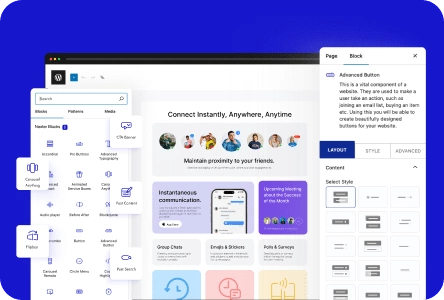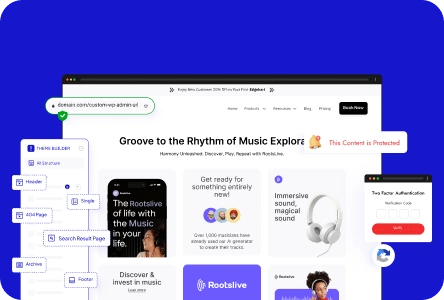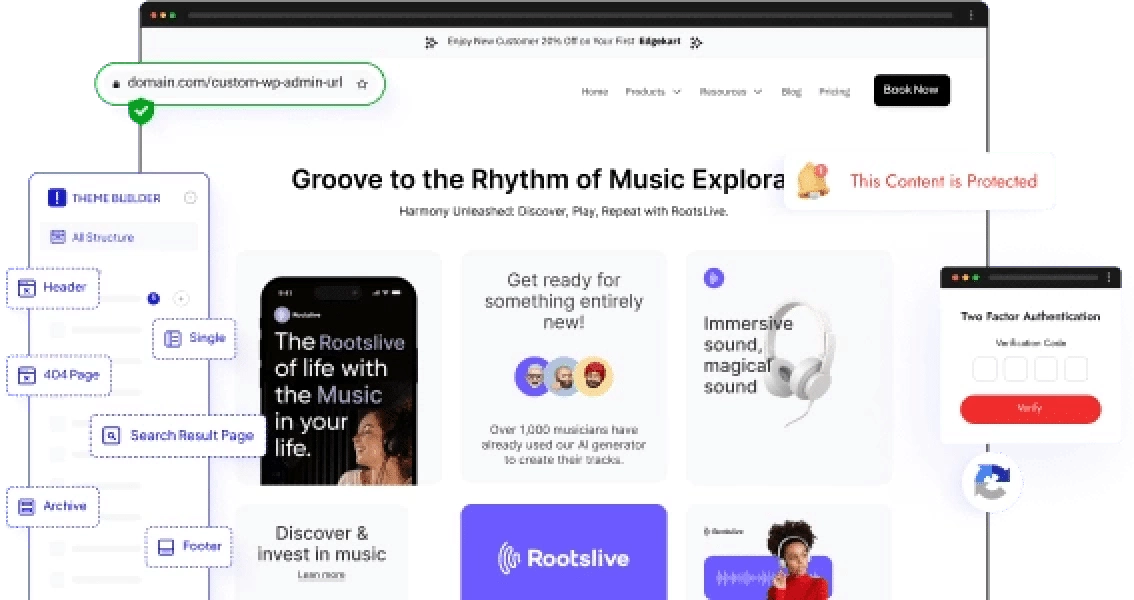Want to Earn Passive Income with Affiliate Marketing?
Affiliate marketing is one of the easiest ways to make money online by promoting products or services. And the secret to real success? Having your own website!
WordPress is the best platform to build an affiliate site—simple, customizable, and SEO-friendly.
In this blog, we’ll show you how to make affiliate marketing website in WordPress in detail. By the end, you’ll be ready to launch and start earning!
Let’s get started.
Why Start an Affiliate Marketing Website?
Affiliate marketing websites offer numerous benefits, making them a smart choice for anyone looking to earn passive income online.
Affiliate marketing is responsible for over 16% of e-commerce sales globally. There are plenty of benefits to having a website for affiliate marketing.
Benefits of Affiliate Marketing Websites
Let’s explore the reasons to start your own affiliate marketing website:
- Increased Credibility – A website makes you look professional and helps build trust with your audience.
- Content Control – You can decide what to publish and how to present it, unlike social media platforms where you have limited control.
- Scalability – As your website grows, you can add more affiliate products, create new content, or expand into other niches.
- Long-Term Asset – A website is a valuable digital asset that can generate income over time and even be sold if needed.
- Custom Branding – You can design your website to reflect your unique style, making it easier to stand out in a competitive market.
- Monetization Options – Besides affiliate links, you can also earn through ads, sponsored posts, or selling digital products on your website.
- Flexibility – You can update and refine your content, adding value for your audience and improving your earning potential.
- Global Audience Reach – Affiliate marketing enables you to connect with potential customers worldwide, making it an excellent choice for those targeting a diverse, international market.
Can You Really Make Money from Affiliate Marketing?
If you’re wondering whether you can really make money from affiliate marketing, the answer is YES, and many marketers have proof of that.
According to an AffiliateWP study, 81.2% of affiliate marketers report earning over $20,000 annually.
Also, about 15% of affiliates have annual earnings that range from $80,000 to $1 million, according to research by We Can Track.
And it doesn’t stop there! Top performers in the field can make over $150,000 per year, with the highest achievers even surpassing that, as mentioned by Influencer Marketing Hub.
These figures show that with dedication and the right strategies, affiliate marketing can be a lucrative venture.
How to Create an Affiliate Marketing Website in WordPress
We’ll discuss the detailed steps to make an affiliate marketing website in WordPress.
Step 1: Choose a Niche for Your Website
The first step before setting up an affiliate marketing website is to choose your niche wisely.
You’ll be promoting or sometimes educating your audience about the niche you’re working on, so it’s better to choose a niche in which you have decent knowledge. Also, look for a niche that excites you and will keep you motivated in the long run.
For example, if you’re tech-savvy, you can create an affiliate website on ‘software reviews or web hosting guides’.
Or, if you’re good at design, you can choose graphic design as your niche and target tools like Canva or Adobe.
To make things easier for you, here are the following aspects to look at while choosing a niche:
1. Analyze Market Demand
A profitable niche must have demand. Research whether people are actively searching for solutions or products in the niche.
You can use Google Trends to identify trending or evergreen topics.
![How to Make Affiliate Marketing Website in WordPress [Step-by-Step Guide] 1 Market Demand](https://nexterwp.com/wp-content/uploads/2025/01/Market-Demand.webp)
Also, you can check forums (Reddit, Quora) or social media for common questions or discussions related to these topics.
2. Look for profitability
Choose a niche that offers products or services with high commission potential. (e.g., SaaS tools often provide recurring commissions, and tech gadgets like smart home devices may generate high commissions during peak seasons).
Check affiliate programs offering better commissions. For instance, promoting a $500 product with a 10% commission may earn you more than promoting a $20 product with a 20% commission.
3. Evaluate long-term potential
Some niches are seasonal, while others provide year-round income. Check if the niche is evergreen or does it has consistent demand (e.g., health, tech, finance) Will it grow over time, like AI tools or cybersecurity?
4. Analyze the Competition
Competition signals profitability, but too much can make it hard to stand out.
So, research competitors in your niche. Look at their blogs, YouTube channels, or social media pages. Analyze their content strategy, affiliate programs, and audience engagement.
Check how saturated the niche is and identify gaps where you can add unique value.
Once you have a clear niche in mind, then you can proceed next on how to make an affiliate marketing website in WordPress.
Let’s look at what you need to create a WordPress affiliate marketing website.
Step 2: Set Up WordPress and Hosting
WordPress software is free, but you need to pay for a web host and domain name for your new website.
Domain Name a is your website’s unique address on the internet (e.g., www.yourwebsite.com). Users type this name into their browsers to access your site.
A web host is a service that provides the infrastructure to store your website’s files and make them accessible online. Think of it as the home where your website lives.
You should choose a reliable web host for your website to ensure optimal speed, security, and performance. Some of the popular and reliable web hosting providers are Hostinger, SiteGround, GoDaddy, Bluehost, NameCheap, and HostGator.
Some web host providers also provide domain name registration services. So, conduct your research and then choose wisely according to reviews and budget.
![How to Make Affiliate Marketing Website in WordPress [Step-by-Step Guide] 2 Set Up WordPress and Hosting](https://nexterwp.com/wp-content/uploads/2025/01/Set-Up-WordPress-and-Hosting.png)
Once your hosting and domain are set up, the next step is to design your website professionally to match your niche, engage visitors, and provide a smooth user experience, which is crucial for creating a successful affiliate marketing website.
WordPress’s default editor, Gutenberg (Blocks Editor), offers a drag-and-drop interface with customizable blocks to help you create a visually appealing and functional website. But if you want to take your design to the next level, tools like Nexter Blocks are quite helpful.
Nexter Blocks enhances Gutenberg’s capabilities, giving you more flexibility to design pages that look professional, load quickly, and boost engagement. From call-to-action buttons to dynamic carousels or even a Table of Contents, Nexter Blocks makes it simple to create a website that stands out while staying lightweight and optimized.
![How to Make Affiliate Marketing Website in WordPress [Step-by-Step Guide] 3 Nexter blocks](https://nexterwp.com/wp-content/uploads/2025/01/Nexter-blocks.webp)
Step 3: Install Essential Plugins and Themes
One of the reasons WordPress is one of the best platforms for affiliate marketing is its incredible variety of plugins and themes. These tools not only enhance your website’s functionality but also help you manage and grow your affiliate marketing site with ease.
Here are some essential plugins to consider for your affiliate marketing website:
- AffiliateWP – It’s a beginner-friendly affiliate management plugin with a user-friendly front-end dashboard, making it easy for you to manage affiliate accounts.
- ThirstyAffiliates – This plugin helps you organize, cloak, and insert affiliate links effortlessly into your content. Also, ThirstyAffiliates tracks clicks to show you what’s working best.
- Pretty Links – This plugin cleans up long, messy affiliate URLs by turning them into short, branded links that are easy to share and build audience trust.
- Nexter- For a polished, professional website design, you can download Nexter. With its 1,000+ ready-to-import customizable starter templates and sections, you can easily design your website. Paired with Gutenberg Blocks, you can add engaging features like social feeds and reviews, image carousels, and stylish post layouts to elevate your site.
![How to Make Affiliate Marketing Website in WordPress [Step-by-Step Guide] 4 affiliate marketing](https://nexterwp.com/wp-content/uploads/2025/01/affiliate-marketing.webp)
- Akismet: It will help you protect your site from spam comments, keeping your website professional and secure.
- Yoast SEO: This plugin helps you make your content search-engine-friendly by providing actionable tips on keyword usage, link building, readability, and more. A well-optimized content is more likely to rank higher, increasing the chances of more visitors to your site.
![How to Make Affiliate Marketing Website in WordPress [Step-by-Step Guide] 5 Yoast SEO](https://nexterwp.com/wp-content/uploads/2025/01/Yoast-SEO.webp)
With the right plugins and themes, you can transform your WordPress site into a powerful affiliate marketing platform that looks great and performs even better.
You can also check out valuable tips to speed up your WordPress website.
Step 4: Create Content for Your Website
Content is the heart of any affiliate marketing website.
People often rely on recommendations to make informed decisions about products or services. So, by creating honest product reviews, detailed tutorials, and thoughtful comparison posts, you can establish your website as a credible source.
Types of Content to Focus On:
- Product Reviews: Share detailed, unbiased reviews of the products or services you promote. Highlight the pros, cons, and use cases to help readers make informed choices.
- Tutorials: Create step-by-step guides on how to use the products, addressing common problems and showing practical solutions.
- Comparison Posts: Compare similar products, detailing their features, pricing, and performance so readers can pick the best option for their needs.
- Listicles: Examples like “Top 10 Gadgets for Fitness Enthusiasts” or “Best Tools for Affiliate Marketers” can capture attention quickly.
Your goal should be to guide readers toward making confident decisions. By the time they finish reading, they should have no doubts about investing in the product or service you’re recommending.
Step 5: Join Affiliate Programs
Joining affiliate programs is where the magic truly begins. This step connects your website with the products and services you’ll promote to earn commissions.
The easiest way to start is by looking at popular platforms that host a wide range of affiliate programs to monetize your affiliate site.
Here are a few trusted options:
- Amazon Associates: Perfect for beginners, it lets you promote millions of products from the world’s largest online store.
- ShareASale: A hub for affiliate programs across various niches, from fashion to tech.
- CJ Affiliate (formerly Commission Junction): Offers access to big-name brands and a vast array of promotional opportunities.
- Specialized Programs: Many brands run their own affiliate programs. A quick search like “brand name + affiliate program” can lead you to hidden gems.
For example, if you liked Nexter for your WordPress website, then you can join Nexter’s affiliate program and start promoting Nexter to WordPress users.
You can guide new WordPress users on how Nexter can make their site stand out and increase its functionality. Share honest reviews, highlight your favorite features, and explain how Nexter transformed your own website. Your genuine recommendations can inspire trust and encourage others to give it a try!
Step 6: Drive Traffic to Your Website
You’ve set up your affiliate marketing website, joined the right programs, and started creating amazing content. Now comes the critical part – getting people to visit your site!
Let’s dive into some effective strategies to get traffic for your affiliate marketing website.
1. Master SEO (Search Engine Optimization)
SEO is your best friend when it comes to driving organic traffic. You need to use the right keywords that can help you generate traffic for your site.
Use tools like Google Keyword Planner or Ubersuggest to find search terms your audience is searching for related to your niche and incorporate these keywords naturally in your content.
Optimize your headings, meta descriptions, and URLs.
Also, reach out to other websites for guest posts or collaborations to earn quality backlinks.
2. Use Social Media
Social media platforms are quite helpful for traffic if used effectively:
Share your blog posts regularly on platforms where your audience hangs out, like Instagram, LinkedIn, or Pinterest.
Create engaging posts or reels to showcase snippets of your content.
You can also join niche-specific groups or forums to share value (without spamming links).
2. Leverage the Power of Email Marketing
Build an email list to keep your audience updated about new content and product recommendations.
Send regular newsletters with valuable tips, product updates, and links to your blog posts.
Use personalization to connect with readers on a deeper level.
An engaged email list is like having a loyal traffic source that keeps coming back!
By mastering SEO, tapping into social media, and connecting with your audience through email, you’ll create a steady stream of visitors who trust your recommendations and keep coming back for more.
How to Monetize Your Affiliate Marketing Website
Here we’ll discuss some effective affiliate marketing strategies to monetize your website. So, let’s have a look.
Add Affiliate Links Strategically
Add affiliate links strategically within your content to make sure your WordPress affiliate marketing website is optimized for conversions.
1. Place affiliate links naturally within your content to make your affiliate website more user-friendly and increase affiliate sales. For example:
- In product reviews, add links where you mention specific features or benefits.
- In tutorials, include links when you recommend tools or products to complete a task.
- In comparison posts, add links in the table or summary for easy access.
- Avoid cramming links into every sentence. It can come off as spammy and reduce trust.
- Place links in prominent locations such as:
- At the top: Add a link early in your content for readers who don’t scroll much.
- Within the Content: Place links in the flow of your writing for a natural user experience.
- At the End: Summarize your recommendations and include links as a takeaway.
- Disclose Transparently – Always let your readers know you’re using affiliate links. Transparency builds trust, and many affiliate programs require disclosure for compliance. A simple note like, “This post contains affiliate links. If you purchase through these links, we may earn a commission at no extra cost to you,” is sufficient.
Use Display Ads
Adding display ads to your website is a great way to boost your income alongside affiliate marketing. Platforms like Google AdSense allow you to display ads on your site and earn money whenever visitors view or click on them.
Using both affiliate links and display ads creates multiple income streams, increasing your earning potential. For example:
- Affiliate Links work best when visitors are interested in products you recommend.
- Display Ads generate income regardless of whether visitors click your affiliate links or not.
To make the most of display ads on your affiliate website, focus on smart placement and relevance. Position ads where they’re likely to grab attention, such as at the top of your page or within your content, without being intrusive.
Offer Paid Memberships or Products
Diversifying your income is a smart move, and offering paid memberships or products can take your earnings to the next level.
Think of it as creating exclusive content that your most loyal audience is happy to pay for.
Ideas to Get Started:
- eBooks: Compile your expertise into a downloadable eBook that solves a problem or dives deep into your niche. For instance, a guide on “Mastering Affiliate Marketing” could be a big hit.
- Online Courses: Teach your audience what you know through video tutorials or step-by-step lessons. Platforms like Teachable or Udemy make it easy to launch your course.
- Exclusive Memberships: Offer premium content like advanced tips, live webinars, or community access for a monthly fee. This works especially well if your audience is already engaged with your free content.
Once you know what they’re willing to pay for, you can expand your offerings and grow your income even further!
Stay updated with Helpful WordPress Tips, Insider Insights, and Exclusive Updates – Subscribe now to keep up with Everything Happening on WordPress!
Wrapping Up
We have discussed the steps in detail on how to make an affiliate marketing website in WordPress easily.
Also, in this blog, you can find valuable affiliate marketing tips and strategies that can help you succeed in your affiliate marketing business. You can take inspiration from here for starting a blog.
WordPress is an excellent platform both for beginners and non-technical users to easily set up a site and start earning commissions. Combined with Nexter Blocks, you can improve your website’s user experience, making it stand out from the rest.
With over 90+ customizable Gutenberg blocks, Nexter Blocks helps you create an amazing and engaging website. Check the complete list of 90+ Nexter Blocks available that you might be a good fit for your site.
Frequently Asked Questions About Affiliate Marketing Websites
How much does it cost to start an affiliate website?
Starting an affiliate website typically costs between $50 to $200 for domain, hosting, and basic tools. Additional expenses may include content creation and marketing, which can be scaled as your site grows.
Do I need technical skills to create an affiliate website?
No, you don’t need advanced technical skills. Platforms like WordPress make it easy to create and manage your affiliate website without coding.
How long does it take to make money from affiliate marketing?
It usually takes 3 to 6 months to see consistent earnings from affiliate marketing, depending on factors like niche, traffic, and content quality.
What are the best niches for affiliate marketing in 2024?
Profitable niches in 2024 include health, technology, personal finance, e-commerce, home improvement, beauty and skincare, travel, digital marketing, and online education. Niches like AI and eco-friendly products are also growing in popularity.
Can I do affiliate marketing part-time?
Yes, affiliate marketing can be done part-time. Many people start while working full-time and gradually scale up their websites as they gain experience and traffic.





